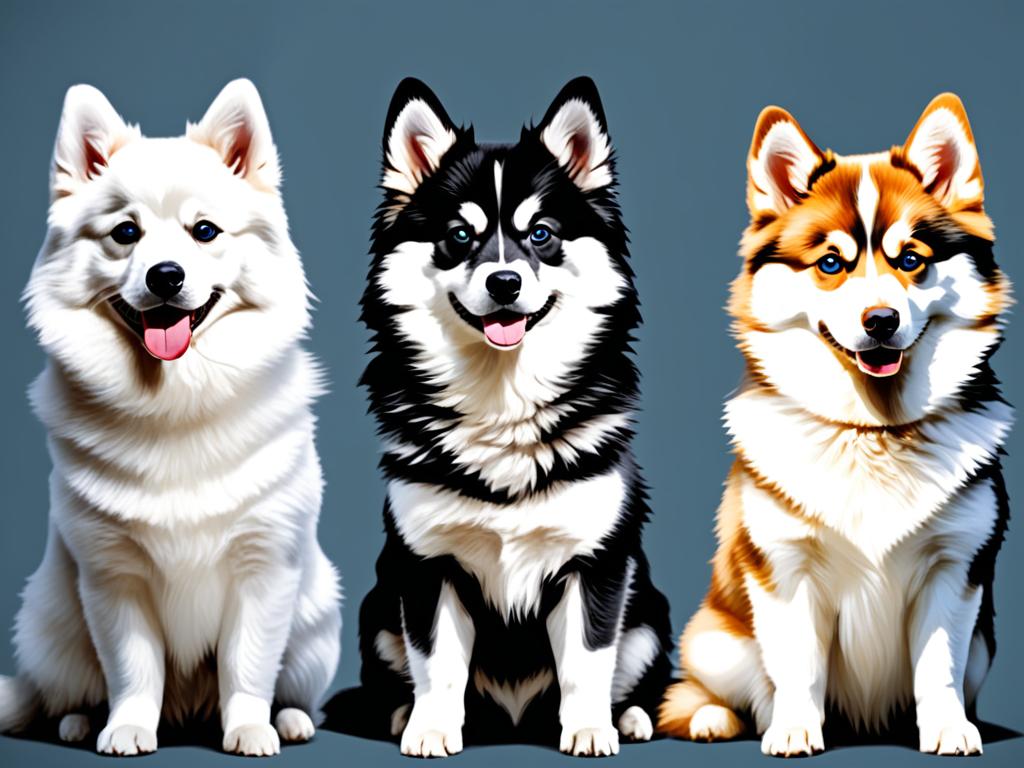Did you know that the average lifespan of a Pomsky is between 12 to 15 years? These adorable dogs, a cross between Pomeranians and Siberian Huskies, bring joy and energy into the lives of their owners. But just like any other breed, there are factors that can affect their lifespan.
Key Takeaways:
- Providing proper nutrition, regular exercise, and veterinary care can help extend your Pomsky’s lifespan.
- Factors such as genetics, diet, exercise, and overall health can impact the lifespan of a Pomsky.
- Common health issues in Pomskies include hip dysplasia, eye problems, and dental issues.
- The size, generation, and gender of a Pomsky can also influence their lifespan.
- Proper care and attention during each aging stage can promote a longer and healthier lifespan for your Pomsky.
Factors That Affect Pomsky Lifespan
Several factors can influence the lifespan of a Pomsky. These include diet, exercise, veterinary care, and breeding.
Diet: A balanced diet that contains all essential nutrients is crucial for the growth and development of your Pomsky. Providing high-quality dog food that is appropriate for their size, age, and specific dietary needs is essential. Consult with your veterinarian for guidance on the best diet for your furry friend.
Exercise: Regular exercise is important for maintaining good physical health in Pomskies. These energetic dogs need daily physical activity to burn off excess energy and stay in shape. Engage in activities like walks, playtime, and interactive toys to keep your Pomsky active and mentally stimulated.
Veterinary Care: Regular visits to the vet are essential for ensuring the overall health of your Pomsky. Routine check-ups allow for early detection of any health issues and prompt treatment. Vaccinations, parasite prevention, and dental care are also important aspects of veterinary care that can contribute to a longer and healthier lifespan.
Breeding: Choosing a reputable breeder who practices ethical breeding methods is crucial for the health and lifespan of your Pomsky. Responsible breeders perform health screenings on their breeding dogs to minimize the risk of genetic health issues being passed on to the puppies. When getting a Pomsky, do thorough research and choose a breeder who prioritizes the well-being of their dogs.
| Factors Affecting Pomsky Lifespan | Importance |
|---|---|
| Diet | Crucial |
| Exercise | Important |
| Veterinary Care | Essential |
| Breeding | Crucial |
Common Health Issues That Affect Pomskies
Pomskies, like all dogs, are prone to certain health issues that can impact their lifespan. It is important for Pomsky owners to be aware of these common health problems and take preventive measures to ensure the well-being of their beloved pets.
Hip Dysplasia
Hip dysplasia is a common orthopedic condition in dogs, including Pomskies. It occurs when the hip joint doesn’t develop properly, leading to discomfort, pain, and lameness. Regular exercise and maintaining a healthy weight can help reduce the risk of hip dysplasia in Pomskies. If diagnosed, treatments such as medication, physical therapy, and surgery may be necessary to alleviate symptoms.
Eye Problems
Pomskies are susceptible to various eye problems, including cataracts and glaucoma. Cataracts cause cloudiness in the lens and can lead to vision impairment or blindness. Glaucoma, on the other hand, is characterized by increased pressure within the eye and can result in vision loss if left untreated. Regular eye check-ups with a veterinarian can help detect these issues early on and allow for appropriate treatment.
Dental Issues
Poor dental hygiene can cause a range of dental problems in Pomskies, such as gum disease and tooth decay. Plaque and tartar buildup can lead to inflammation of the gums and infections. Regular dental care, including brushing your Pomsky’s teeth and providing dental chews or treats, can help prevent these issues. Routine dental checkups and professional cleanings are also important for maintaining good oral health.
| Common Health Issues in Pomskies | Preventive Measures |
|---|---|
| Hip Dysplasia | Regular exercise and weight management |
| Eye Problems (Cataracts, Glaucoma) | Regular eye check-ups and prompt treatment |
| Dental Issues (Gum Disease, Tooth Decay) | Regular dental care and checkups |
By addressing these common health issues and providing the necessary care, Pomsky owners can contribute to their pet’s overall well-being and potentially extend their lifespan. It is always recommended to consult with a veterinarian for personalized advice and guidance on keeping your Pomsky healthy and happy for years to come.

Tips for Extending Your Pomsky’s Life Span
To extend your Pomsky’s lifespan, there are several tips you can follow. Taking proactive measures to promote their overall health and well-being can significantly contribute to a longer and happier life for your furry friend.
1. Provide a Balanced Diet
Ensuring that your Pomsky receives a balanced diet that meets their nutritional needs is essential for their longevity. Consult with your veterinarian to determine the appropriate diet for your dog based on their age, size, and specific dietary requirements. High-quality dog food that contains essential nutrients will support their overall health and help prevent nutritional deficiencies.
2. Regular Grooming Sessions
Regular grooming sessions not only keep your Pomsky looking their best, but they also play a crucial role in maintaining their health. Grooming helps to keep their coat clean and tangle-free, preventing skin issues that can arise from poor hygiene. Additionally, grooming sessions provide an opportunity to inspect their skin for any abnormalities or signs of infection.
3. Regular Exercise
Regular exercise is vital for your Pomsky’s physical and mental well-being. Engage them in activities that match their energy levels, such as walks, playtime, or interactive toys. Exercise helps to keep their weight in check, improves cardiovascular health, and boosts their overall fitness. Consult with your veterinarian to determine the appropriate exercise regimen for your Pomsky based on their age and fitness level.
4. Routine Veterinary Checkups
Regular visits to the veterinarian are crucial for early detection and prevention of potential health issues. Schedule routine checkups to ensure that your Pomsky receives age-appropriate vaccinations, dental care, and screenings for common health problems. Your veterinarian can also provide guidance on specific care needs and address any concerns you may have regarding your Pomsky’s health.
5. Create a Healthy and Safe Living Environment
Creating a healthy and safe environment for your Pomsky is essential for their well-being. Ensure that their living space is clean, free from hazards, and offers adequate space to move and play. Keep toxic substances, harmful plants, and small objects out of your Pomsky’s reach to prevent accidents or ingestion of harmful substances. Providing them with a comfortable bed and a quiet place to rest can promote their overall relaxation and reduce stress levels.
Incorporating these tips into your Pomsky’s daily routine can make a significant difference in extending their lifespan. By prioritizing their health and well-being, you can enjoy many happy and healthy years with your beloved Pomsky companion.
How Size and Generation Affect Pomsky Lifespan
The lifespan of a Pomsky can be influenced by both its size and generation. Factors such as size-related health issues and breeding generation play a role in determining how long a Pomsky is expected to live.
Size and Lifespan
The size of a Pomsky can impact its lifespan. Teacup and toy Pomskies, which are smaller in size, tend to have a shorter lifespan compared to miniature and standard Pomskies.
Teacup and toy Pomskies are more prone to health issues related to their small size. These health issues can include fragile bones, respiratory problems, and organ complications, which can ultimately affect their lifespan.
On the other hand, miniature and standard Pomskies have a lifespan similar to that of most small to medium-sized dog breeds. They are less likely to encounter size-related health issues, allowing them to live a relatively longer life.
Generation and Lifespan
The generation of a Pomsky can also affect its lifespan. Pomskies are typically categorized into various generations, including first-generation (F1), second-generation (F2), and so on.
First-generation Pomskies, which are a cross between a Pomeranian and a Siberian Husky, are considered to be healthier and may have a longer lifespan compared to later generations. This is because first-generation Pomskies are less likely to inherit genetic health issues from their parents.
Later generations of Pomskies, such as F2 or F3, may have a higher risk of inheriting health issues from previous generations, which can impact their lifespan.
When choosing a Pomsky, it’s important to consider both size and generation. Understanding the potential health risks associated with different sizes and generations can help you make an informed decision that promotes a longer and healthier lifespan for your furry companion.

Male vs Female Pomsky Lifespan
When it comes to the lifespan of Pomskies, there is a slight difference between males and females. Generally, female Pomskies have a slightly longer lifespan compared to males. However, it’s important to note that the difference in lifespan is primarily seen in desexed (neutered or spayed) dogs. Desexed Pomskies tend to live longer as the procedure can reduce the risk of health issues such as obesity and cancer.
It’s worth mentioning that gender alone does not have a significant impact on the lifespan of Pomskies. Other factors like genetics, diet, exercise, and overall health play a more crucial role in determining the lifespan of these adorable mixed breed dogs.
Comparison of Male and Female Pomsky Lifespan
| Gender | Average Lifespan |
|---|---|
| Male | 12-15 years (Desexed: Slightly longer lifespan) |
| Female | 12-15 years (Desexed: Slightly longer lifespan) |

As shown in the table, both male and female Pomskies have an average lifespan of 12 to 15 years. The slight difference in lifespan between the genders is primarily seen in desexed Pomskies, with both males and females enjoying a slightly longer lifespan when desexed. It’s important to consider factors beyond gender, such as proper nutrition, exercise, and regular veterinary care, to ensure a happy and healthy life for your Pomsky regardless of their gender.
How Aging Stages Affect Pomsky Lifespan
Pomskies, like all dogs, go through different aging stages that can have an impact on their lifespan. Understanding and addressing the unique characteristics and challenges of each stage is essential for promoting a longer and healthier life for your beloved Pomsky.
The Aging Stages of a Pomsky
1. Socialization Period: This stage occurs from birth to around 16 weeks of age. It is crucial for your Pomsky to be exposed to different environments, people, and animals during this period. Proper socialization helps them develop into well-rounded and confident adults.
2. Testing Period: Also known as the fear-imprint period, this stage typically occurs around 8 to 12 weeks of age. During this time, your Pomsky may display fearful behavior and may be more prone to developing anxieties. Providing a secure and supportive environment is essential to help them navigate through this stage.
3. Adolescent Stage: This stage occurs between 6 months to 2 years of age. Pomskies may challenge boundaries and exhibit behavioral changes during this period. Consistent training, positive reinforcement, and patience are key to guiding them through this stage.
4. Adulthood: Once your Pomsky reaches adulthood, usually around 2 to 6 years of age, they have reached their mature size and temperament. It’s important to continue providing regular exercise, mental stimulation, and a balanced diet to maintain their overall health.
5. Senior Stage: The senior stage begins around 7 to 10 years of age and onwards. Pomskies may start experiencing age-related health issues such as joint problems or decreased energy levels. Regular veterinarian checkups, a nutritious diet, and appropriate exercise tailored to their changing needs can help support their well-being.
Promoting Pomsky Lifespan through Proper Care
To ensure a longer and healthier lifespan for your Pomsky, it’s crucial to provide proper care and attention during each aging stage:
- During the socialization period, expose your Pomsky to various stimuli, including different environments, people, and animals to help them develop confidence.
- Throughout the testing period, create a safe and secure environment, avoiding negative experiences that could lead to fearful behaviors.
- During the adolescent stage, continue training and positive reinforcement to guide your Pomsky through behavioral changes and establish boundaries.
- As your Pomsky enters adulthood, maintain regular exercise to support their physical health and provide a balanced diet to meet their nutritional needs.
- In the senior stage, adjust their exercise routine to accommodate any age-related limitations and ensure regular veterinary checkups to catch and address any health issues early on.
By understanding the unique characteristics and challenges of each aging stage and providing the appropriate care and attention, you can help extend your Pomsky’s lifespan and enjoy many years of companionship together.
The Use of Rapamycin to Extend Pomsky Lifespan
Rapamycin, a drug originally used to treat cancer in humans, has shown promise in extending the lifespan of dogs. Research studies have demonstrated that rapamycin can enhance heart function and promote a more youthful heart in dogs. While further studies are needed, some dog owners have reported positive effects of rapamycin on their aging pets. However, it’s important to note that rapamycin should only be used under the guidance of a veterinarian due to potential side effects.
When it comes to extending the lifespan of your Pomsky, the use of rapamycin has gained attention in recent years. Rapamycin is an immunosuppressive drug that was initially developed to prevent organ rejection in transplant patients. It inhibits the target of rapamycin (TOR) pathway, a key regulator of cell growth and aging.
Although rapamycin is still under investigation for its anti-aging effects in dogs, early studies have shown promising results. In a study published in Nature Communications, researchers found that rapamycin treatment enhanced heart function and reduced age-related cardiac decline in dogs.

Research has also shown that rapamycin can improve insulin sensitivity, reduce age-related obesity, and delay the onset of age-related diseases in various animal models. These findings suggest that rapamycin may have the potential to extend the healthy lifespan of dogs, including Pomskies.
However, it’s important to proceed with caution. The use of rapamycin should only be done under the supervision of a qualified veterinarian. Rapamycin is a powerful drug with potential side effects, including immunosuppression and gastrointestinal issues. An experienced veterinarian can evaluate your Pomsky’s health and determine if rapamycin is a suitable treatment option.
Additionally, it’s worth mentioning that rapamycin is not currently approved for use in dogs by the U.S. Food and Drug Administration (FDA). While it may be possible to obtain rapamycin through a compounding pharmacy or with a veterinarian’s prescription, it’s crucial to remember that off-label use of medications should be approached with caution.
In conclusion, rapamycin shows promise as a potential tool for extending the lifespan of Pomskies and other dogs. However, further research is needed to fully understand its effects and determine appropriate dosages and treatment regimens. If you’re considering rapamycin for your Pomsky, consult with a knowledgeable veterinarian who can provide guidance based on your dog’s specific health needs.
Conclusion
In conclusion, the average lifespan of a Pomsky is between 12 to 15 years. However, several factors can influence their lifespan, including genetics, diet, exercise, and overall health. Providing proper care, including a balanced diet, regular exercise, and veterinary checkups, can help extend your Pomsky’s lifespan. Additionally, being aware of common health issues and considering factors like size and generation when choosing a Pomsky can contribute to a longer and healthier life for your furry companion.
By understanding the factors that affect the lifespan of Pomskies, you can make informed decisions to ensure your pet lives a long and happy life. Genetics play a significant role, so choosing a reputable breeder with a focus on health testing is crucial. Providing a nutritious diet that meets their specific needs and engaging in regular exercise not only benefits their physical health but also promotes mental stimulation. Regular veterinary checkups allow for early detection and treatment of any potential health issues, further enhancing their longevity.
In summary, while Pomskies have an average lifespan of 12 to 15 years, proactive measures can extend their life expectancy. By prioritizing their well-being through proper care, nutrition, exercise, and regular veterinary care, you can enjoy the companionship of your Pomsky for many years to come.
FAQ
What is the average lifespan of a Pomsky?
The average lifespan of a Pomsky is between 12 to 15 years.
What factors can affect the lifespan of a Pomsky?
Several factors can influence the lifespan of a Pomsky, including genetics, diet, exercise, and overall health.
What are some common health issues in Pomskies?
Some common health problems in Pomskies include hip dysplasia, eye problems, and dental issues.
How can I extend my Pomsky’s lifespan?
To extend your Pomsky’s lifespan, you can provide a balanced diet, regular exercise, veterinary care, and create a healthy living environment.
How does the size and generation of a Pomsky affect its lifespan?
Teacup and toy Pomskies tend to have a shorter lifespan due to size-related health issues. First-generation Pomskies are considered healthier and may have a longer lifespan compared to later generations.
Is there a difference in lifespan between male and female Pomskies?
Female Pomskies generally have a slightly longer lifespan compared to males, especially when spayed or neutered.
How do aging stages affect a Pomsky’s lifespan?
Pomskies go through different aging stages, each of which can impact their lifespan. Proper care and attention during each stage can help promote a longer and healthier lifespan.
Can rapamycin be used to extend a Pomsky’s lifespan?
Rapamycin has shown promise in extending the lifespan of dogs, including Pomskies. However, it should only be used under the guidance of a veterinarian due to potential side effects.

Leave a Reply